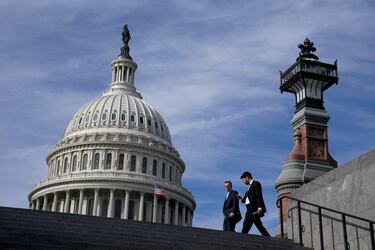How was the government shutdown averted and when is the next deadline?
Congress was heading towards a government shutdown but Wednesday saw the Republican-controlled chamber pass a stopgap bill.

On Wednesday, and with Thanksgiving looming, the Senate successfully passed a temporary funding bill to prevent a government shutdown, buying time until early next year. The House had already approved the bill a day earlier, (here is what it contained), and it now just requires President Joe Biden’s signature to ease concerns. At least in the short term.
87–11: Senate approves House-passed stopgap funding measure.
— CSPAN (@cspan) November 16, 2023
The bill now heads to President Biden for his signature ahead of the Friday midnight deadline to avert a government shutdown. https://t.co/QNIroKXvfY pic.twitter.com/uRs8gstQoV
Senate passes stopgap bill to avoid shutdown
The measure extends funding for specific priorities until 19 January 2024, with the rest of the government funded until 2 February. However, the two-step approach has set up potential conflicts in January and February over budget negotiations. House conservatives, unhappy with the lack of deep spending cuts in the plan, necessitated Democratic support for passage. The situation poses a leadership challenge for newly elected House Speaker Mike Johnson, who aims to avoid a last-minute, massive spending bill in December. Here is what he posted on X a few days ago.
This two-step continuing resolution is a necessary bill to place House Republicans in the best position to fight for conservative victories. The bill will stop the absurd holiday-season omnibus tradition of massive, loaded up spending bills introduced right before the Christmas…
— Speaker Mike Johnson (@SpeakerJohnson) November 11, 2023
Despite concerns and warnings, the bill passed, with more House Democrats supporting it than Republicans, raising potential challenges for Speaker Johnson’s leadership. The future dynamics will depend on how he handles the pressure from conservative factions advocating for their priorities.
How often does the US government shutdown?
Over the past four decades, the United States federal government has experienced ten shutdowns, with the most extended one lasting an unprecedented thirty-five days from December 2018 to January 2019. The 2018-2019 shutdown unfolded as Republicans, under President Trump’s leadership, withheld support for a spending bill in a push to secure funding for the border wall.
Although the Democrats gained the majority in the House in early January 2019, they remained steadfast, leading to the eventual capitulation of the Republicans. Notably, every government shutdown in the last thirty years has transpired when the Republicans held control of the House of Representatives.
We’ve prevented a government shutdown, again.
— Senator Mark Kelly (@SenMarkKelly) November 16, 2023
And again, I’m frustrated that Washington is kicking the can down the road for government funding and our needs on the border and aid for our allies.
We need to come together on a bipartisan plan to fund the government long-term.
What is the impact of a US government shutdown?
Government shutdowns, particularly on the scale of the United States, pose significant logistical challenges and financial burdens. The Congressional Budget Office estimated that the most recent five-week shutdown resulted in a staggering $11 billion reduction in economic output. Approximately $3 billion had to be allocated to compensate furloughed federal workers, and the IRS reported an additional $2 billion in losses due to the inability to carry out tax compliance activities. Beyond direct costs, the shutdown had cascading effects, including slowed business operations as furloughed workers stayed home, disruptions in public transit systems around Washington DC, and production delays as businesses assessed impacts on their supply chains. Various agencies also reported losses in fees, particularly those linked to the closure of national parks and other services.
Shutdowns also raise concerns among credit rating agencies like Moody’s, Standard & Poor’s, and Fitch, which closely monitor a government’s fiscal health. The risks associated with shutdowns have prompted these agencies to reassess the creditworthiness of the US government. A downgrade in credit rating could lead to higher borrowing costs and diminish investor confidence in the US economy. Note that the downgrade on 5 August 2011 marked the first time the US credit rating fell below AAA.

Related stories
During the 2018-2019 shutdown, over 380,000 workers were furloughed, and an additional 420,000 had to work without immediate pay. While federal workers were eventually compensated, many federal contractors, including low-wage workers like security officers, custodians, cooks, and landscapers, were left unpaid for the hours lost during the shutdown. This situation drew widespread condemnation from progressive Democrats and activists, highlighting the economic vulnerability of these workers.
At least, for the moment, the latest one in 2023 has been averted. Let’s see how things look in early 2024.

